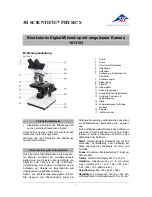
60
9. Contrast methods for Leica DM4000 B/DM4500 P/DM5000 B
9.1 Transmitted light
9.1.1 Bright field (TL)
• Switch to the transmitted light axis (TL) by
pushing the
TL/IL
function key.
• Select the
BF
(bright field) contrast method.
Do so by pressing the
BF
variable key.
Alternatively: press the variable button
CHANGE TL
.
(For details on key assignments, please see
the identification sheet.)
The display indicates
BF
.
• Insert a transmitted light specimen.
• Rotate an appropriate objective into place.
• Use the focus wheel to bring the image into
focus and set the brightness using the
INT
function key.
9.1.2 Phase contrast (TL)
• Switch to the transmitted light axis (TL) by
pushing the
TL/IL
function key.
• Select the PH (phase contrast) contrast meth-
od.
Do so by pressing the variable button
PH
.
Alternatively: press the variable button
CHANGE TL
.
(For details on key assignments, please see
the identification sheet.)
The display indicates
PH
.
• Insert a transmitted light specimen.
• Rotate an appropriate objective into place.
Objectives that are suitable for phase con-
trast are engraved with PH.
• Bring the image into focus using the focus
wheel and set the brightness using the
INT
function key.
Notes:
The microscope automatically selects the cor-
rect light ring in the condenser.
When selecting the phase contrast method, the
aperture diaphragm is opened fully and can not
be adjusted.
9. Contrast methods for Leica
DM4000 B/DM4500 P/DM5000 B




































